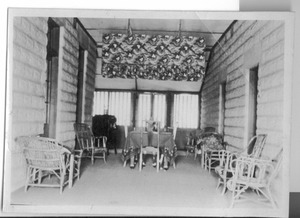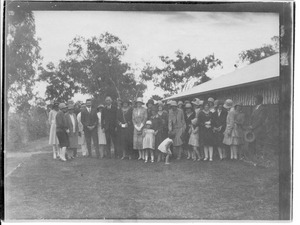The Residency, Alice Springs facts for kids
Quick facts for kids The Residency |
|
|---|---|

A view of the Parsons Street side of The Residency, 2007
|
|
| General information | |
| Location | Alice Springs, Northern Territory, Australia |
| Construction started | 1926 |
| Completed | 1927 |
The Residency is a special building in Alice Springs, Australia. It represents a time when Central Australia had its own government. It was also a busy place for social events and cultural activities for people living there.
In 1926, John Charles Cawood became the Government Resident for Central Australia. He was based in Stuart, which is what Alice Springs was called back then.
Building The Residency
The Residency was designed to be cool in a hot, dry climate. Its concrete floors were laid right onto the earth. The building was made from special hollow concrete bricks. These bricks looked like stone and were made on site.
Workers found sand from the Todd River to mix with cement for the bricks. The building was finished in 1927.
Cool Features of The Residency
A main feature of the house was a breezeway that ran through its middle. This open area was often used as a lounge. It had comfy cane furniture and a tea table. A special fan called a punkah helped keep the breezeway cool. An Aboriginal servant would operate the punkah.
Rooms opened off each side of this breezeway. A wide veranda, covered with fly screens, surrounded the building. Today, this veranda has sliding windows and green striped blinds to help keep the house cool.
Changes Over Time
The Residency has been updated many times. For example, the front room on the left was once a laundry and storeroom. Later, new rooms were added at the back for a storeroom and laundry. This allowed for a new bedroom, which was much appreciated by the people living there.
The main breezeway was sometimes called 'the freezeway' in winter. It later became a dining area. Different families lived in The Residency, so this space changed to fit their needs.
The house had four fireplaces, one in each main room. Doors opened onto the veranda. This design helped keep the house warm in winter and cool in summer. Alice Springs can get very cold in winter and extremely hot in summer!
People Who Lived Here
Many important people lived in The Residency over the years.
John Charles Cawood (1927–1929)
John Charles Cawood was the first Government Resident. He lived here from February 1927 to December 1929. He was also in charge of a special inquiry in 1928. Mr. Cawood left his position because his wife was unwell.
Victor Carrington (1929–1942)
Victor Carrington moved into The Residency in 1929. He was the Assistant Administrator and later a District Officer. The Carrington family lived there until 1942.
Aubrey Abbott (1942–1945)
Aubrey Abbott was the Administrator of the Northern Territory. He usually lived in Darwin. After a bombing in Darwin in 1942, he moved the government's main office to Alice Springs. Mr. Abbott stayed at The Residency until November 1945.
LH A Giles (1945–1946)
LH A Giles was the Government Secretary for a short time. He lived in The Residency until May 1946.
Colonel Lionel Rose (1946–1955)
Colonel Lionel Rose was a very interesting person. He was the Chief Veterinary for the Northern Territory. People say The Residency was a lively social spot when he lived there from July 1946 to February 1955.
Reginald McCaffery (1955–1960)
Reginald McCaffery, his wife Billie, and their large family lived here next. Mr. McCaffery found there weren't enough bedrooms. He added simple partitions on the veranda to create more sleeping areas for his family. He lived in The Residency from February 1955 to December 1960.
Dan Conway (1960–1973)
Dan Conway and his wife Jillna were the last District Officers to live in the building. They made many changes for a special event in 1963. Queen Elizabeth II and the Duke of Edinburgh stayed at The Residency for two nights in March 1963.
To get ready for the Royal Visit, a new roof, air conditioning, and two new bathrooms were added. A private area on the veranda was made for the Queen to read her mail. The Conways lived at The Residency until July 1973.
The Residency Today
In 1973, Alice Springs became a municipality (a self-governing town). The Museum and Art Gallery of the Northern Territory then took over The Residency. They used it to show art, natural science, and local history items.
The Residency was re-opened in 1996. Today, it is home to Heritage Alice Springs Inc. Visitors can explore this beautiful old home. It was once the main place for social, government, and official events in early Alice Springs.
Heritage Listings
The Residency is an important historical site. It was added to the Northern Territory Heritage Register on 14 July 1995. This means it is protected for its historical value.
Images for kids








